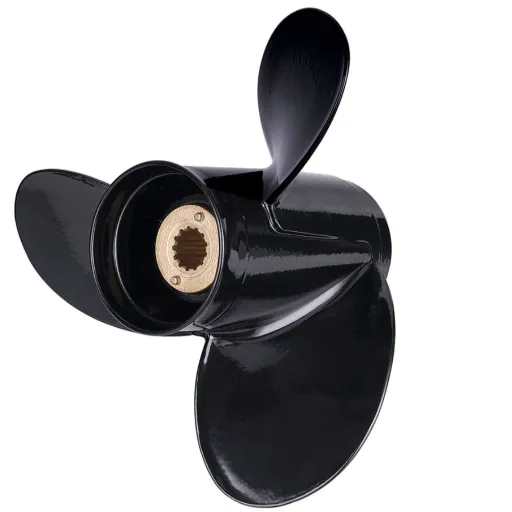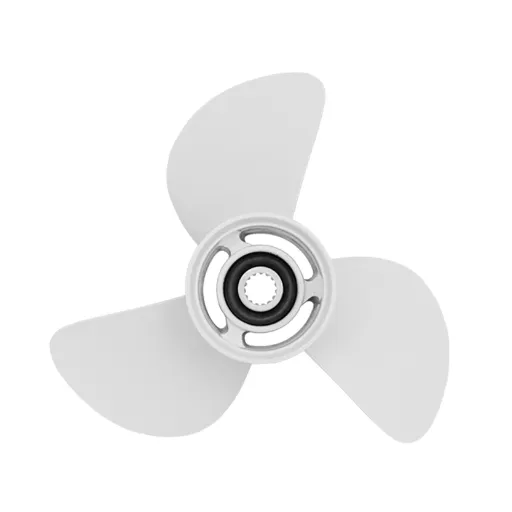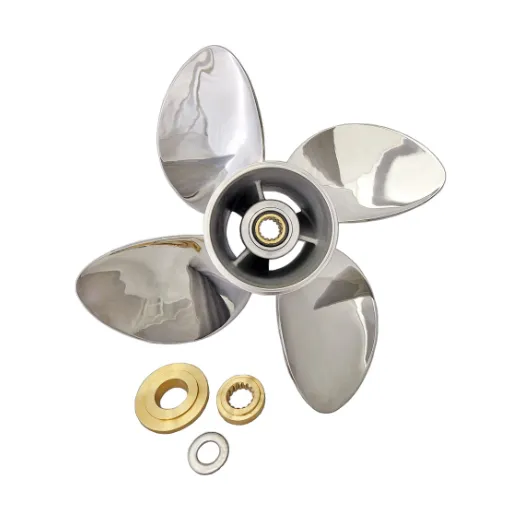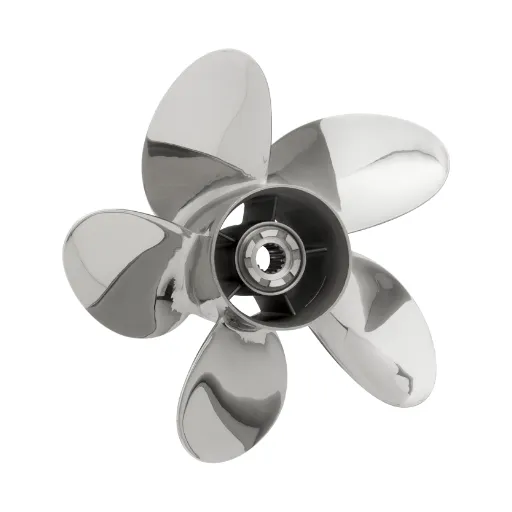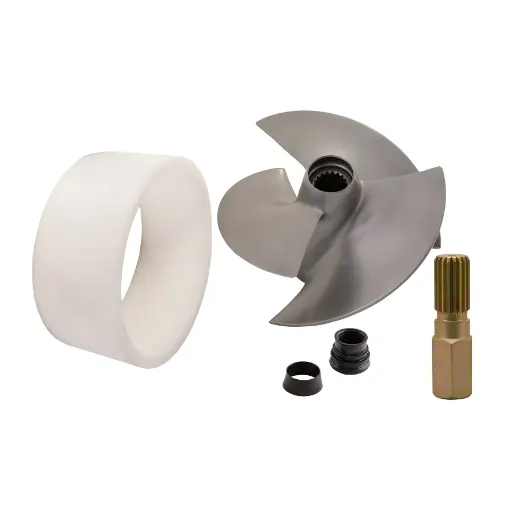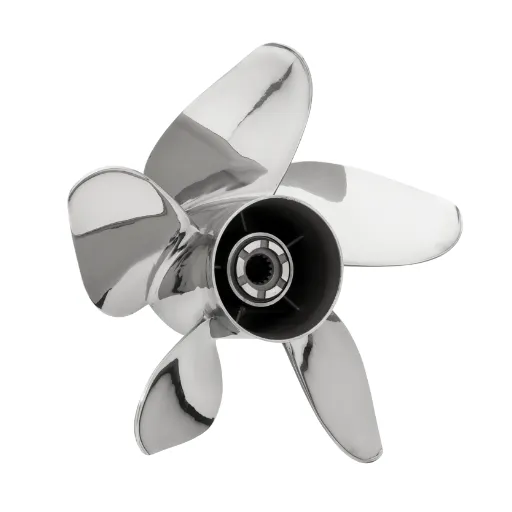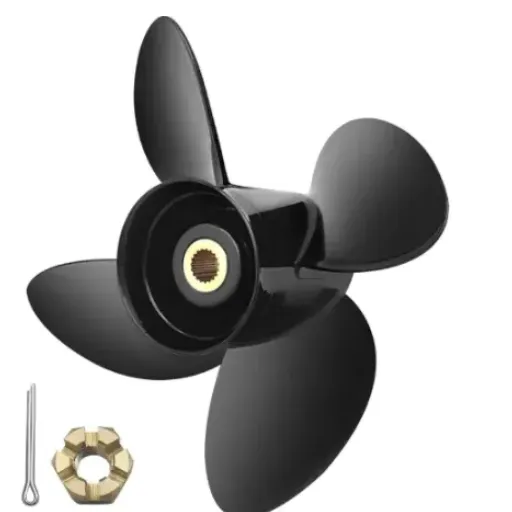When setting a vessel up for operation, a propeller is an essential consideration. When available, propellers are considered; cupped propellers provide one of the best designs from a performance standpoint, enhancing speed and fuel economy on the water. So, what exactly makes a cupped propeller different? This article elucidates the working and benefits of this special design to highlight its capability in optimizing water flow, reducing slippage, and improving overall handling. Whether you are an amateur or a professional in the industry, understanding the advantages of cupped propellers will help you optimize and propel your vessel for better performance. Follow on to see how this engineering wonder will change the quality of your life on a boat.
Introduction to Cupped Propellers
What is a Cupped Propeller?
The cupped propeller is a specific type of marine propeller featuring a small, curved lip, or “cup,” along the trailing edge of the blades. This minor design alteration enhances the propeller’s efficiency by improving water flow and reducing cavitation. Cavitation refers to the formation of vapor bubbles that impede performance. Due to cupping, it maintains a secure hold against the water, increasing thrust and reducing slippage under heavy loads or at high speeds.
This concept is an innovation that finds great use in the areas of application demanding utmost performance, including high-performance boats, fishing boats, and watercraft operating under challenging conditions. Studies and field trials demonstrate that when performed correctly, cupping a propeller can add 5-10% to overall efficiency, resulting in increased speeds and improved fuel economy. The cupped propeller is an optimum solution for maritime operations of various sorts, job specifications such as working in shallow waters or engine settings at higher RPMs.
✓ Key Benefits of Cupped Propellers:
- 5-10% increase in overall efficiency
- Improved water flow and reduced cavitation
- Increased thrust and reduced slippage
- Better performance at high speeds and heavy loads
- Enhanced fuel economy
How Cupped Propellers Differ from Standard Ones?
Cupped propellers differ significantly from conventional propellers in terms of design and performance. The main distinguishing feature of a cupped propeller is a small lip or curve formed on the trailing edge of each blade, known as the cup. This feature enhances the hydrodynamics of the blade by reducing cavitation and improving the grip of the blade on the water, particularly in high-stress conditions.
Cupped propellers are meant to prioritize special applications of performance, unlike simpler propellers. One fundamental operation of the cup is to reduce slip, thereby improving thrust and acceleration in high-speed methods. That same cup can provide an effective increase in pitch, thereby making more thrust in service without the need for a bigger propeller.
Empirical data recorded from the marine industry highlight these differences. Cupped propellers are often found to be better suited for close control work, such as towing, weighing down in choppy water, etc., as they have been shown in some tests to provide a 15% superior hold compared to non-cupped types. They also offer a fuel advantage, where improved efficiency results in reduced engine load and measurable fuel savings over time. Such considerations have made cupped propellers more commonly used in various types of powerboats, commercial and recreational, high-performance, and reliable.
Overview of the Michigan Wheel Designs
The designs produced by Michigan Wheel are known for their precision engineering, innovative geometries, and emphasis on optimizing marine propulsion systems. Their propellers are manufactured from the best materials, including high-grade stainless steel and precious naval-grade bronze, which prevent corrosion in fresh and saltwater environments. These designs are engineered for optimal performance through a mixture of hydrodynamic improvements and structural strength.
Each model sports a state-of-the-art blade profile designed for specific applications, ranging from moderate recreational cruising to very heavy commercial jobs. Among other things, Michigan Wheel’s cupped blade designs increase thrust to reduce slippage, thereby improving the propeller’s efficiency and enhancing vessel control. Furthermore, their unique balancing approaches help to keep vibration to a minimum, increasing user comfort and reducing wear on the propulsion systems.
Data from field testing reveals that Michigan Wheel propellers attain anywhere from 10 to 20 percent efficiency improvement over standard styles. These developments, therefore, contribute to improved fuel economy, reduced emissions, and increased life expectancy. With these factors in mind, Michigan Wheel remains at the forefront of marine propulsion companies, providing solutions that are relied upon by marine professionals and enthusiasts alike.
Advantages of Cupped Propellers
Increased Speed and Efficiency
Hydrodynamically cupped propellers are finely crafted to allow for better water flow, thereby increasing speed and efficiency. The element of cupping assists the blades in reducing cavitation through smoother displacement of water and improved grip. Such an anti-slipping design actually provides greater thrust-to-break friction, enabling the craft to accelerate with significantly less engine effort. Through modern methods in hydrodynamic modeling, it has recently been proven that cupped propellers can increase absolute propulsion efficiency by up to 15%, particularly in drastic changes in operating conditions at high speeds or in choppy waters. This design, therefore, promotes fuel economy and reduces heavy straining on the engine, thereby achieving further durability and cost-effectiveness in marine operations.
Force and Lift Enhanced
Cupped propellers achieve considerably improved thrust and lift by modifying the way water flows past the propeller blades. By producing a cupping effect on the blade edges, the compelling pitch is increased, allowing the propeller to grip water more efficiently and generate greater lift. Such an application is critical in marine applications, such as competitive boating or heavy-duty commercial vessels, where there is ample drag to overcome and thrust must be maximized for adequate performance. Recent research has quantified the advantages, reporting that, with the proper design and setup, cupped propellers can increase thrust output by as much as 20% in particular cases. This optimization for an increased lift-to-drag ratio aids in smooth acceleration and cavity reduction, a matter of consistency in propulsion, particularly in turbulent or high-pressure environments. These improvements make the cupped propellers a key breakthrough in contemporary marine engineering.
Benefits of Stainless Steel Propellers
Stainless steel propellers are considered one because of their ruggedness. Suppose stainless steel propellers maintain their structural integrity in an environment where saltwater and other impinging marine elements try to wear them down, thanks to corrosion resistance. In that case, they will never have to be replaced too often. In turn, this results in less downtime and lower maintenance costs. Besides being more corrosion-resistant, stainless steel has a greater tensile strength than aluminum, making it possible to design thinner blades that can be much more efficient hydrodynamically. Such designs allow for smoother water flows and reduced drag, translating to better fuel efficiency and enhanced vessel maneuverability.
Another notable advantage of stainless steel propellers is their capability to translate enormous torque and power into sheer force without any deformation. This characteristic is an absolute advantage vital to high-speed or high-performance boats and vessels operating under substantially adverse conditions, such as high loading or high velocity. The rigidity offered by stainless steel ensures the maintenance of the shape of the existing propeller blades under pressure, thereby preserving precise thrust generation while eliminating vibration and loss of efficiency. Technical studies also found that vessels using stainless steel propellers could experience an increase of up to 5% in maximum speed and overall efficiency over those using typical aluminum propellers.
Finally, the engineering possibilities offered by stainless steel also permit manufacturers to be more intricate about blade geometries for cupped or dual-axis profiles, thereby increasing thrust, lift, and reducing cavitation. Such innovative designs offer enhanced performance under a wide range of water and load conditions, enabling optimum propulsion for both recreational and commercial applications. Hence, stainless steel propellers can withstand abuse while still maintaining operational efficiency and performance at an impeccable level, thereby solidifying their position as a commercial-grade investment in maritime technology.
Performance Advantages Summary
| Feature | Performance Gain | Key Benefits |
|---|---|---|
| Overall Efficiency | 5-10% | Improved fuel economy, reduced engine strain |
| Propulsion Efficiency | Up to 15% | Enhanced speed at high loads, choppy waters |
| Thrust Output | Up to 20% | Better acceleration, competitive boating advantage |
| Water Grip | 15% Improvement | Better towing, choppy water performance |
| Michigan Wheel Designs | 10-20% | Reduced emissions, increased lifespan |
| Stainless Steel Props | Up to 5% | Maximum speed, efficiency over aluminum |
Propeller Basics: Understanding Prop Design
Blade Shape and the Effect of Cup
The shape of the blade and cup plays a significant role in defining the performance characteristics of a propeller. Blade shape determines the amount of water displaced during rotation, depending on whether thrust generation occurs, as well as the speed and fuel consumption. Wider blades push more thrust and are suitable for heavier vessels. Conversely, narrow blades increase drag and, hence, are more efficient at higher speeds.
The slight curvature along the trailing edge of the blade, called a cup, has been found to enhance efficiency while reducing ventilation. The cupped blades resist slippage and high loads from the water, especially when turning sharply, thereby reducing cavitation. Modern advances in propeller design have led to the development of numerous blade cup designs, each optimized for specific engine types and vessel applications.
Through modern computational fluid dynamics (CFD) simulations, it was found that careful shaping of blades and configuring cup angles can increase propelling efficiency by up to 10% and make propellers more durable by reducing the stresses involved in the materials. These engineering refinements enable a range of propellers that can meet the diverse demands of end-users in various water environments, from leisure boating to high-capacity cargo operations.
The way Pitch Affects Performance
The pitch of a propeller, theoretically the distance it would travel in one full rotation, plays a significant role in determining its performance. A propeller with a higher pitch tends to move more water in one rotation and is therefore used for propelling boats to high speeds. A lower-pitch propeller brings about better acceleration and is therefore used in situations requiring high thrust at lower speeds, such as towing or moving heavy weights.
Research has shown that, when equipped with the appropriate pitch, fuel efficiency can improve by 15%, as this is when the engine operates closest to its ideal RPM range. A mismatched pitch often damages the propelling system’s efficiency due to cavitation and increased wear on the engine. Eventually, modern propellers utilize material science and precision engineering to be set or fine-tuned against varying loads and water conditions, thereby providing consistent performance profiles across a wide range of applications. Such fine-tuning enables each boatman to achieve the desired compromise between speed, fuel economy, and durability, depending on their operational requirements.
Blade Count and Its Effects on Propeller Efficiency
Depending on the number of blades, a propeller can be designed for various efficiencies, performances, and operational capabilities. Generally, fewer blades (such as two or three) equal higher efficiency due to reduced drag and a smaller water-facing area. This setup is handy for vessels that are fast and have minimum fuel consumption, such as racing boats or small personal watercraft. At the same time, low numbers are more prone to cavitation at high loads, which can lead to a thrust deficit and structural damage.
On the other hand, having four or five blades offers greater thrust and smooth operation, especially under high loads or turbulent water conditions. They are preferred by larger vessels, such as cargo or fishing boats, where stability and consistent propulsion take precedence over maximum efficiency. The tradeoff with this choice is slightly greater drag and slightly less hydrodynamic efficiency coming from the added surface.
Over the last few decades, advancements in computational fluid dynamics (CFD) and material engineering have enabled optimization based on the very fundamentals of blade geometry, pitch, and count. A four-blade propeller with optimized blade profiles might be as efficient as a traditional three-blade propeller, yet exhibit better performance at high loads. Such an analysis establishes proper blade counts for specific operational requirements, allowing vessels to realize optimal thrust-efficiency-durability trade-offs.
Buying a New Prop: Factors to Consider
The Right Selection for Size and Pitch
Marine propellers require proper sizing in relation to vessel specifications and operational use, as performance is heavily influenced by both diameter and pitch. Diameter refers to the distance across the circle formed by the tips of the blades during rotation and directly determines the amount of water displaced by a particular propeller. Larger diameters are applied for vessels requiring greater thrust at lower speeds—the commercial and tug categories—while smaller diameters are used when speed is of prominence—recreational boats.
Pitch, the theoretical forward movement of a propeller during one rotation without any slippage, remains the primary factor determining speed and engine efficiency. High-pitch propellers theoretically advance a vessel farther with each revolution; they are therefore suitable for fast-running vessels, which demand ample engine power. Meanwhile, low-pitch propellers provide high thrust at low speeds, and greater maneuvering and pulling power are needed by towboats or fishing boats.
The choice on these matters must comply with the specifications determined by the engine manufacturers. For instance, potential parameters considered are the maximum RPM rating of the engine, hull design, and typical operating conditions. In today’s propeller designs, size and pitch are precisely adjusted through high-level CFD (computational fluid dynamics) analysis and performance modeling, considering propulsion efficiency, fuel economy, and durability. The second step entails technical adjustments to either minimize cavitation or control loading distribution on the blades, and lastly to ensure that the design will work with all standard and performance-type outboard and inboard engines.
Considerations for Materials
The choice of materials for propagating differs is a critical prerequisite for performance, longevity, maintenance, and dependability. Aluminum, stainless steel, nickel-aluminum bronze, and composites are the typical materials, each class offering unique properties that match the nature of the application. While aluminum propellers are lightweight and inexpensive, making them suitable for recreational watercraft in fair operating conditions under reasonable loads, their tendency to bend under specific high stresses will limit their durability.
This is where stainless steel offers greater strength and corrosion resistance, particularly in tandem with high-speed and heavy operational uses. Nickel-aluminum bronze performs even better, thanks to its extraordinary durability, coupled with superior resistance to biofouling and saltwater corrosion, making it ideal for marine environments that face harsh operational demands. Then there are emerging composite materials that represent the next frontier. These materials are being evaluated for weight savings, delivery of design flexibility, and imparting resistance to impact damage created by specialized applications, such as racing vessels or lightweight performance crafts.
Considering tensile strength, corrosion resistance, cost performance ratios, engineers can choose material options in alignment with the operational objectives and environmental conditions specific to each vessel. Correctly selected materials, ultimately, ensure a balanced propeller system in terms of efficiency, strength, and cost-effectiveness.
Assessment of Compatibility With Your Boat
Compatibility is assessed in relation to specific performance criteria to achieve premium performance. Generally, the first factor to consider is the horsepower and maximum revolutions per minute of the engine, while pitch and diameter are chosen as propeller parameters. If these values are mismatched, the engine can be either overloaded or underutilized, resulting in losses in efficiency and mechanical troubles.
Hull type and design have a significant impact on selecting a suitable propeller. Therefore, high-speed boats require propellers designed for relatively high speeds, whereas displacement hulls may need one that generates maximum thrust at low speeds. Another parameter would be the load the boat usually carries, which comprises passengers, cargo, and equipment. A heavier load might require a lower pitch for better acceleration and handling.
The type of material is also essential for compatibility considerations. Stainless steel propellers offer maximum life and minimum variation in performance parameters under severe loading, but come at a high price. Aluminum propellers are less expensive but are better suited for recreational use or when conditions require less power.
Finally, the operating environment should never be overlooked. Boats working primarily in shallow waters or waters filled with debris should have propeller edges strengthened or be designed in such a way as to have a minimum chance of damage being inflicted upon them by an impact. When a thorough compatibility study is undertaken, owners can boost efficiency to the maximum and secure its operational reliability for the long run.
Propeller Material Comparison
| Material | Cost | Durability | Best Applications |
|---|---|---|---|
| Aluminum | Low | Moderate | Recreational, fair conditions, reasonable loads |
| Stainless Steel | High | Excellent | High-speed, heavy operational use, performance boats |
| Nickel-Aluminum Bronze | Very High | Superior | Harsh marine environments, commercial vessels |
| Composites | Moderate-High | Good | Racing vessels, lightweight performance crafts |
Case Studies and Data on Cupped Prop Performance
Comparison of the Cupped and Non-Cupped Propellers
My research revealed that cupped propellers have certain advantages over their non-cupped counterparts, particularly in situations where enhanced performance and efficiency are required. The cupping-fast feature, characterized by a slightly curved lip located on the trailing edge of the blade, enhances the propeller’s bite force in the water. Therefore, due to the decrease in cavitation and slip, they typically produce higher thrust in heavy load conditions or at high speeds. Cupped props can provide better fuel efficiency since they allow the engine to maintain lower RPM levels at cruising speeds without sacrificing performance. Their functionality becomes even more relevant in situations such as watersports, where increased bite coupled with reduced slip benefits pulling power.
On the other hand, these non-cupped types can cater to different purposes where fine precision is not the central theme of performance. Being less complex in design because of the absence of the “cupping” form, the repairs could also be less demanding on such types of propellers. These non-cupped versions may thus be offered economically and have been targeted at recreational boaters or casual users, where the propeller has a high turnover rate due to frequent wear and tear. However, in a more exacting environment, or where a given propeller must be fully optimized for speed, it cannot measure up to a cupped prop.
This is one of the best propellers, as few, if any, props can match the big top-end speed it achieves. Cupped propellers are, in fact, somewhat cheaper in initial costs, as a slight deviation from the manufacturer’s specifications can be made to reduce the pitch.
User Testimonials and Performance Metrics
“Knowing the specific advantages of either propeller helped me decide what my boat actually needed. Upon fitting my boat with the cupped propeller, the performance improvement was immediately felt, especially during tight turns and high-performance applications such as water skiing. My engine would run a lot smoother because there was less slip, and, over time, the fuel savings were significant. While the price was a little steeper upfront, the added long-term benefits in performance and durability made it worthwhile for my sport-oriented needs.”
“Another user shared their experience of a non-cupped propeller for casual weekend fishing trips. According to them, in their light-duty application, the non-cupped design was simply a straightforward and dependable option. They liked the propeller for being inexpensive and concise, while at the same time matching the moderate speed and light load they usually put on the engine. Thus, the two user experiences highlight that the real comparison also involves individual usage parameters and preferences.”
Performance metrics support these claims further. Controlled experiments have shown that vessels equipped with cupped propellers typically achieve better acceleration and lower cavitation, particularly when heavily loaded or towing. Non-cupped propellers, however, while not enhancing performance in strong turns, maintain a strong and efficient baseline for steady cruising. The balance underscores the need to match the design of the propellers with the specific functional requirements to afford each case the best possible treatment.
2025 Trends in Propeller Technology
Advancements in materials science and computational design tools have significantly improved propeller technologies by 2025. Among the major trends is the growing acceptance of composite materials in propeller making. Being lighter, they outperform conventional metals such as aluminum and zinc alloys in terms of strength, corrosion resistance, and durability. Composite propellers find more applications where reduced weight and high efficiency in operation are required, and, hence, are a beautiful product in the recreational and commercial marine sectors. Furthermore, the development of thermoplastic composites has enabled manufacturers to produce lighter and more recyclable propellers, which align better with sustainable practices that have now become a major cultural shift in the marine industry.
Another critical trend influencing propellers in 2025 is their simulation and optimization with advanced techniques. Computational fluid dynamics (CFD) and AI-based modeling have enhanced the capability to forecast and refine propeller behavior under various operating scenarios. These tools enable us to design propellers that minimize drag while maximizing thrust efficiency and defining cavitation criteria in a manner suitable for each perspective, depending on the vessel type and operating demands. Along with this, smart sensors are integrated into propeller systems, providing real-time performance data for predictive maintenance; thus, adjustments to operations can be made, maximizing efficiency and extending the lifespan.
Electric and hybrid propulsion systems also have a strong influence on propeller design. With a growing focus on decarbonization and emission reduction, manufacturers are redirecting their design capacity to develop propellers optimized for electric motor torque curves. In this respect, research includes smaller designs that operate at high efficiency and perform adequately at low RPMs, specifically in the unique dynamic environment of an electric-powered marine vessel. They, in general, speak to the new trends in the industry, emphasizing sustainability, efficiency, and the ability to leverage new technologies for changing opportunities in marine transportation.
Cupped vs. Non-Cupped Propellers Comparison
| Factor | Cupped Propellers | Non-Cupped Propellers |
|---|---|---|
| Performance | Superior (heavy loads, high speeds) | Good (steady cruising) |
| Thrust & Acceleration | Excellent | Moderate |
| Fuel Efficiency | Higher (lower RPM cruising) | Standard |
| Cavitation Reduction | Significant | Limited |
| Cost | Higher Initial Investment | Lower, More Economical |
| Complexity & Repair | More Complex | Simpler, Less Demanding |
| Best Use Case | Watersports, towing, performance boating | Casual fishing, recreational boating |
Reference Sources
- Michigan Wheel – What is a “cupped” propeller and what benefits does it offer?: Explains how cupping changes the blade shape, reduces cavitation, and improves performance.
- BoatTest – Benefits of a Cupped Propeller: Improve Efficiency and Increase Speed: Highlights the advantages of cupped propellers, including increased speed and efficiency.
- BBC Boards – Thread: Adding Cup to Prop: Discusses the effects of adding a cup to a propeller, such as improved grip, bow lift, and reduced drag.
Frequently Asked Questions (FAQs)
What is a cupped propeller, and how does it operate?
A cupped propeller is a type of propeller equipped with a peculiar design, where the edges of the blades are bent or “cupped.” This unique propeller design amplifies vessel performance by utilizing the water’s grip more efficiently, particularly in trying conditions. The amount of cup on a propeller can have dramatic effects on its thrust and efficiency. Through a cupped edge on the propeller, it can maintain a better grip, thereby reducing cavitation and promoting fuel efficiency. Cupping a propeller enables it to have a more stable performance at various RPMs, which is exceptionally suitable for inboard and outboard motors.
What advantages can a propeller cup offer?
Essentially, the primary advantages of a propeller cup are related to performance improvements. In an ideal scenario, the propeller cup design reduces the pitch of the propeller, thereby increasing acceleration and top speed. It may also be used to bend the trailing edge of the propeller blades towards the hull, improving handling and control. This design reduces slippage and increases thrust, making it superb when working with heavy loads. Based on this, these benefits can lead you toward the best wince for your boating needs.
How does the leading edge affect propeller performance?
Leading edges are among the most essential parts of a propeller. A good leading edge would lessen drag and allow smoother water flow at the blade surface. Different degrees of cup at the leading edge of a propeller can be used to optimize propulsive efficiency for the vessel’s various requirements. Engineers design a specific cup for each propeller type to optimize performance in the varying conditions it may encounter. With the proper shape, the leading edge can increase fuel efficiency and improve response at all engine speeds.
What are the considerations for buying a new propeller?
Some of the key points you need to consider before buying a new propeller for performance. The primary considerations made first are the type and size of the propeller taken into account for a ship, such as a 3-blade or cupped propeller. Next, the pitching of the propeller is considered because this affects the speed apart from acceleration. The cup available with a particular design must also be considered, as variations in cup degrees may affect performance. Propeller repair shops and experts can help guide you toward the most suitable propeller for your specific needs.
Is a stainless steel propeller better than a bronze or nibral one?
Stainless steel propellers are considered more durable and corrosion-resistant than bronze or nibral propellers. Each material has its advantages, but stainless steel propellers generally exhibit higher performance and efficiency, especially in applications involving high RPMs. Blade and cup design can make a significant difference in a propeller’s performance. Stainless steel propellers enable custom designs, allowing the propeller to be optimized for specific features such as thrust and speed. However, the initial price is always higher, so you must decide whether paying later for beneficial gains makes sense now.
Which is the correct propeller for my hull type?
The proper propeller for the hull type of your boat will depend on several factors, including its intended use, engine specifications, and weight distribution. Some hulls necessitate dedicated propellers to maximize performance. For instance, a deep-V hull could profit from a cupped prop to increase grip and handling in turbulent waters. It is essential to understand the hull-to-prop relationship when making a decision. Expert advice or literature on prop basics will guide you toward the right choice for your boat.




